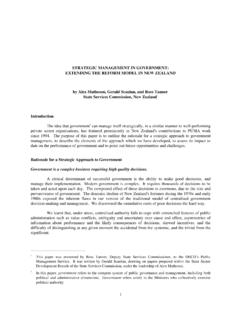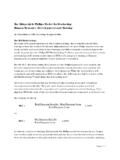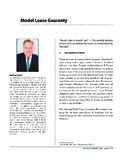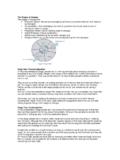Transcription of The PLUS Decision Making Model - Burt Bertram
1 The plus Decision Making Model The Ethics Resource Center Arlington, VA Introduction The traditional Decision Making Model taught in most ethics programs is beyond the reading comprehension level of an estimated 25% of the employee population. We need an alternative Model capable of ensuring that the ethical issues inherent in routine business situations could be effectively surfaced while Making the Model easy to use by people who were functionally semi-illiterate. While developing this alternative Model we kept two overriding conations in mind: Every employee is called upon to make decisions in the normal course of doing his/her job. Organizations cannot function effectively if employees are not empowered to make decisions consistent with their positions and responsibilities.
2 For the Decision maker to be confident in the Decision 's efficacy, every Decision should be tested against the organization's policies and values, applicable laws and regulations as well as the individual employee's definition of what is right, fair, good and acceptable. What we were looking for was a simple set of guidelines that would make it easier for the individual employee, regardless of position or level, to be confident that his/her decisions meet all of the competing standards for effective and ethical Decision - Making used by the organization. The Decision Making process we adopted was carefully constructed to meet several criteria. It had to be: Fundamentally sound based on current theories and understandings of both Decision Making processes and ethics.
3 Simple and straightforward enough that it could be easily integrated into every employee's thought processes. Descriptive (detailing how ethical Decision are made naturally) rather than prescriptive (defining unnatural ways of Making choices). The Decision Making Process We selected a six step Decision Making process that synthesized the Decision Making models used in existing training, not just ethics training. The Model is descriptive of how people intuitively make decisions and makes the steps explicit. The six steps of this natural, intuitive Decision - Making process are: The plus Decision Making Model Ethics Resource Center 2 Step 1: Define the problem The most significant step in any Decision Making process is describing why a Decision is called for and identifying the most desired outcome(s) of the Decision Making process.
4 One way of deciding if a problem exists is to couch the problem is terms of what one wanted or expected and the actual situation. In this way a problem is defined as the difference between expected and/or desired outcomes and actual outcomes. This careful attention to definition in terms of outcomes allows one to clearly state the problem. This is a critical consideration because how one defines a problem determines how one defines causes and where one searches for solutions. The limiting aspect of the problem definition step is not widely appreciated. Consider this example. Your company owns an old, downtown office building. Tenants are complaining that their employees are getting angry and frustrated because there is always a long delay getting an elevator to the lobby at rush hour.
5 You are asked for a reaction on how to solve this problem. As with most problem situations there are several ways to define the situation and several solutions that suggest themselves. This scenario has been presented to over 200 groups in a training environment. The most common alternatives these groups offered were: Flexible hours- so all the tenants' employees wouldn't be at the elevators at the same time. Faster elevators - so each elevator could carry more people in a given time period. Bigger elevators - so each elevator could carry more people per trip. Elevator banks- so each elevator would only stop on certain floors, increasing efficiency. Better elevator controls - so each elevator would be used more efficiently.
6 More elevators - so that overall carrying capacity could be increased. Improved elevator maintenance - so each elevator would be more efficient. Encourage employees to use the stairs - so fewer people would use the elevators. If you examine each alternative you will see that several different definitions of the problem must have existed. If the solution is "flexible hours" the problem must have been defined as, "Too many people getting off work at a given time." No other problem makes sense for that solution. "Faster elevators" comes from, "The elevators are too slow." "Bigger elevators" comes from, "The elevators are not carrying enough people." "More elevators" comes from, "Too few elevators.
7 " The real life Decision makers defined the problem as "people coming about having to wait". Their solution was to make the wait less frustrating by piping music into the elevator lobbies. The complaints stopped. The plus Decision Making Model Ethics Resource Center 3 There is no way that the eventual solution could have been reached if, for example, the problem had been defined as "too few elevators". As you can see, how you define the problem determines where you go to look for alternatives/solutions, so define the problem carefully. Step 2: Identify available alternative solutions to the problem The key to this step is to not limit yourself to obvious alternatives or what has worked in the past but to be open to new and better alternatives.
8 How many alternatives should you identify? Ideally, all of them. Realistically, we teach that the Decision maker should consider more than five in most cases, more than three at the barest minimum. This gets away from the trap of seeing "both sides of the situation" and limiting one's alternatives to two opposing choices; either this or that. Step 3: Evaluate the identified alternatives As you evaluate each alternative, you should be looking at the likely positive and negative cones for each. It is unusual to find one alternative that would completely resolve the problem and is heads and shoulders better than all others. Differences in the "value" of respective alternatives are typically small, relative and a function of the Decision maker's personal perceptions, biases and predispositions.
9 As you consider positive and negative outcones you must be careful to differentiate between what you know for a fact and what you believe might be the case. The Decision maker will only have all the facts in trivial cases. People always supplement what facts they have with assumptions and beliefs. This distinction between fact-based evaluation and non-fact -based evaluation is included to assist the Decision maker in developing a "confidence score" for each alternative. The Decision maker needs to determine not just what results each alternative could yield, but how probable it is that those results will be realized. The more the evaluation is fact-based, the more confident he/she can be that the expected outcome will occur.
10 Step 4: Make the Decision When acting alone this is the natural next step after selecting the best alternative. When the Decision maker is working in a team environment, this is where a proposal is made to the team, complete with a clear definition of the problem, a clear list of the alternatives that were considered and a clear rationale for the proposed solution. The plus Decision Making Model Ethics Resource Center 4 Step 5: Implement the Decision While this might seem obvious, it is necessary to make the point that deciding on the best alternative is not the same as doing something. The action itself is the first real, tangible step in changing the situation.











